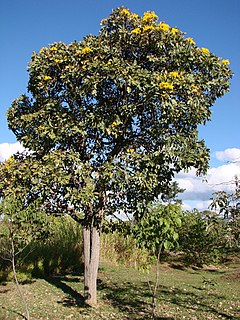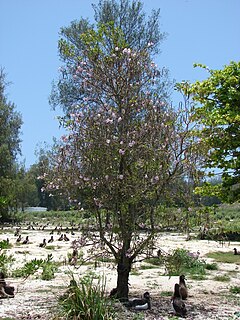
Tabebuia is a genus of flowering plants in the family Bignoniaceae. The common name "roble" is sometimes found in English. Tabebuias have been called "trumpet trees", but this name is usually applied to other trees and has become a source of confusion and misidentification.

Handroanthus serratifolius is a species of tree, commonly known as yellow lapacho, pau d'arco, yellow poui, yellow ipe, pau d'arco amarelo, or ipê-amarelo.

Tabebuia roseo-alba, known as white ipê, ipê-branco or lapacho blanco, is a tree native to Cerrado and Pantanal vegetation in Brazil, but also appears in Argentina and more rarely in Paraguay.

Tabebuia cassinoides is a tree native to Central and South America. It is used as a timber tree to make pencils.
Tabebuia arimaoensis is a species of plant in the family Bignoniaceae. It is endemic to Cuba.
Tabebuia bibracteolata is a species of plant in the family Bignoniaceae. It is endemic to Cuba.
Tabebuia dubia is a species of plant in the family Bignoniaceae. It is endemic to Cuba. It is threatened by habitat loss.
Tabebuia elongata is a species of plant in the family Bignoniaceae. It is endemic to Cuba.
Tabebuia furfuracea is a species of plant in the family Bignoniaceae. It is endemic to Cuba. It is threatened by habitat loss.

Tabebuia hypoleuca is a species of plant in the family Bignoniaceae. It is endemic to Cuba.
Tabebuia lapacho is a species of plant in the family Bignoniaceae. It is found in Argentina and Bolivia. It is threatened by habitat loss.
Tabebuia oligolepis is a species of plant in the family Bignoniaceae. It is endemic to Cuba. It is threatened by habitat loss.
Tabebuia platyantha is a species of plant in the Bignoniaceae family. It is endemic to Jamaica.
Tabebuia shaferi is a species of plant in the family Bignoniaceae. It is endemic to Cuba. It is threatened by habitat loss.

Tabebuia aurea is a species of Tabebuia native to South America in Suriname, Brazil, eastern Bolivia, Peru, Paraguay, and northern Argentina. The common English name Caribbean trumpet tree is misleading, as it is not native to the Caribbean. It is also known as the silver trumpet tree, and tree of gold.

Handroanthus chrysotrichus, synonym Tabebuia chrysotricha, commonly known as the golden trumpet tree, is a semi-evergreen/semi-deciduous tree from Brazil. It is very similar to and often confused with Tabebuia ochracea. In Portuguese it is called ipê amarelo and its flower is considered the national flower of Brazil.

Tabebuia rosea, also called pink poui, and rosy trumpet tree, or Indian Cherry Blossom is a neotropical tree that grows up to 30 m (98 ft) and can reach a diameter at breast height of up to 100 cm (3 ft). The Spanish name roble de sabana, meaning "savannah oak", is widely used in Costa Rica, probably because it often remains in heavily deforested areas and because of the resemblance of its wood to that of oak trees. It is the national tree of El Salvador, where it is called "Maquilíshuat".

Handroanthus is a genus of flowering plants in the family Bignoniaceae. It consists of 30 species of trees, known in Latin America by the common names poui, pau d'arco, or ipê. The latter sometimes appears as epay or simply ipe (unaccented) in English. The large timber species are sometimes called lapacho or guayacan, but these names are more properly applied to the species Handroanthus lapacho and Handroanthus guayacan, respectively.

Tabebuia heterophylla is a species of tree native to the Caribbean, including the Swan Islands of Honduras, and is also cultivated. It is also known as pink manjack, pink trumpet tree, white cedar, and whitewood.

Tabebuia maxonii is a species of Tabebuia native to the Dominican Republic.












